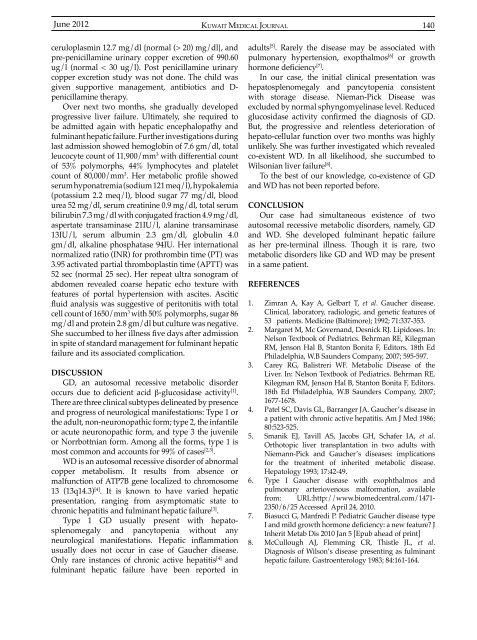Vol 44 # 2 June 2012 - Kma.org.kw
Vol 44 # 2 June 2012 - Kma.org.kw
Vol 44 # 2 June 2012 - Kma.org.kw
You also want an ePaper? Increase the reach of your titles
YUMPU automatically turns print PDFs into web optimized ePapers that Google loves.
<strong>June</strong> <strong>2012</strong><br />
KUWAIT MEDICAL JOURNAL 140<br />
ceruloplasmin 12.7 mg/dl {normal (> 20) mg/dl}, and<br />
pre-penicillamine urinary copper excretion of 990.60<br />
ug/l (normal < 30 ug/l). Post penicillamine urinary<br />
copper excretion study was not done. The child was<br />
given supportive management, antibiotics and D-<br />
penicillamine therapy.<br />
Over next two months, she gradually developed<br />
progressive liver failure. Ultimately, she required to<br />
be admitted again with hepatic encephalopathy and<br />
fulminant hepatic failure. Further investigations during<br />
last admission showed hemoglobin of 7.6 gm/dl, total<br />
leucocyte count of 11,900/mm 3 with differential count<br />
of 53% polymorphs, <strong>44</strong>% lymphocytes and platelet<br />
count of 80,000/mm 3 . Her metabolic profile showed<br />
serum hyponatremia (sodium 121 meq/l), hypokalemia<br />
(potassium 2.2 meq/l), blood sugar 77 mg/dl, blood<br />
urea 52 mg/dl, serum creatinine 0.9 mg/dl, total serum<br />
bilirubin 7.3 mg/dl with conjugated fraction 4.9 mg/dl,<br />
aspertate transaminase 21IU/l, alanine transaminase<br />
13IU/l, serum albumin 2.3 gm/dl, globulin 4.0<br />
gm/dl, alkaline phosphatase 94IU. Her international<br />
normalized ratio (INR) for prothrombin time (PT) was<br />
3.95 activated partial thromboplastin time (APTT) was<br />
52 sec (normal 25 sec). Her repeat ultra sonogram of<br />
abdomen revealed coarse hepatic echo texture with<br />
features of portal hypertension with ascites. Ascitic<br />
fluid analysis was suggestive of peritonitis with total<br />
cell count of 1650/mm 3 with 50% polymorphs, sugar 86<br />
mg/dl and protein 2.8 gm/dl but culture was negative.<br />
She succumbed to her illness five days after admission<br />
in spite of standard management for fulminant hepatic<br />
failure and its associated complication.<br />
DISCUSSION<br />
GD, an autosomal recessive metabolic disorder<br />
occurs due to deficient acid β-glucosidase activity [1] .<br />
There are three clinical subtypes delineated by presence<br />
and progress of neurological manifestations: Type 1 or<br />
the adult, non-neuronopathic form; type 2, the infantile<br />
or acute neuronopathic form, and type 3 the juvenile<br />
or Norrbottnian form. Among all the forms, type 1 is<br />
most common and accounts for 99% of cases [2,3] .<br />
WD is an autosomal recessive disorder of abnormal<br />
copper metabolism. It results from absence or<br />
malfunction of ATP7B gene localized to chromosome<br />
13 (13q14.3) [4] . It is known to have varied hepatic<br />
presentation, ranging from asymptomatic state to<br />
chronic hepatitis and fulminant hepatic failure [3] .<br />
Type 1 GD usually present with hepatosplenomegaly<br />
and pancytopenia without any<br />
neurological manifestations. Hepatic inflammation<br />
usually does not occur in case of Gaucher disease.<br />
Only rare instances of chronic active hepatitis [4] and<br />
fulminant hepatic failure have been reported in<br />
adults [5] . Rarely the disease may be associated with<br />
pulmonary hypertension, exopthalmos [6] or growth<br />
hormone deficiency [7] .<br />
In our case, the initial clinical presentation was<br />
hepatosplenomegaly and pancytopenia consistent<br />
with storage disease. Nieman-Pick Disease was<br />
excluded by normal sphyngomyelinase level. Reduced<br />
glucosidase activity confirmed the diagnosis of GD.<br />
But, the progressive and relentless deterioration of<br />
hepato-cellular function over two months was highly<br />
unlikely. She was further investigated which revealed<br />
co-existent WD. In all likelihood, she succumbed to<br />
Wilsonian liver failure [8] .<br />
To the best of our knowledge, co-existence of GD<br />
and WD has not been reported before.<br />
CONCLUSION<br />
Our case had simultaneous existence of two<br />
autosomal recessive metabolic disorders, namely, GD<br />
and WD. She developed fulminant hepatic failure<br />
as her pre-terminal illness. Though it is rare, two<br />
metabolic disorders like GD and WD may be present<br />
in a same patient.<br />
REFERENCES<br />
1. Zimran A, Kay A, Gelbart T, et al. Gaucher disease.<br />
Clinical, laboratory, radiologic, and genetic features of<br />
53 patients. Medicine (Baltimore); 1992; 71:337-353.<br />
2. Margaret M, Mc Governand, Desnick RJ. Lipidoses. In:<br />
Nelson Textbook of Pediatrics. Behrman RE, Kilegman<br />
RM, Jenson Hal B, Stanton Bonita F, Editors. 18th Ed<br />
Philadelphia, W.B Saunders Company, 2007; 595-597.<br />
3. Carey RG, Balistreri WF. Metabolic Disease of the<br />
Liver. In: Nelson Textbook of Pediatrics. Behrman RE,<br />
Kilegman RM, Jenson Hal B, Stanton Bonita F, Editors.<br />
18th Ed Philadelphia, W.B Saunders Company, 2007;<br />
1677-1678.<br />
4. Patel SC, Davis GL, Barranger JA. Gaucher’s disease in<br />
a patient with chronic active hepatitis. Am J Med 1986;<br />
80:523-525.<br />
5. Smanik EJ, Tavill AS, Jacobs GH, Schafer IA, et al.<br />
Orthotopic liver transplantation in two adults with<br />
Niemann-Pick and Gaucher’s diseases: implications<br />
for the treatment of inherited metabolic disease.<br />
Hepatology 1993; 17:42-49.<br />
6. Type I Gaucher disease with exophthalmos and<br />
pulmonary arteriovenous malformation, available<br />
from: URL:http://www.biomedcentral.com/1471-<br />
2350/6/25 Accessed April 24, 2010.<br />
7. Biasucci G, Manfredi P. Pediatric Gaucher disease type<br />
I and mild growth hormone deficiency: a new feature? J<br />
Inherit Metab Dis 2010 Jan 5 [Epub ahead of print]<br />
8. McCullough AJ, Flemming CR, Thistle JL, et al.<br />
Diagnosis of Wilson’s disease presenting as fulminant<br />
hepatic failure. Gastroenterology 1983; 84:161-164.
















